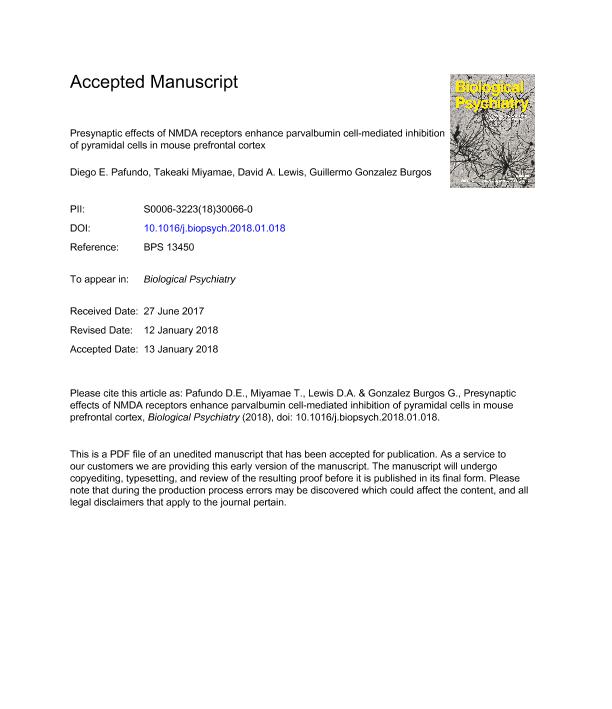Artículo
Presynaptic Effects of N-Methyl-D-Aspartate Receptors Enhance Parvalbumin Cell–Mediated Inhibition of Pyramidal Cells in Mouse Prefrontal Cortex
Fecha de publicación:
09/2018
Editorial:
Elsevier Science Inc
Revista:
Biological Psychiatry
ISSN:
0006-3223
Idioma:
Inglés
Tipo de recurso:
Artículo publicado
Clasificación temática:
Resumen
Background: Testing hypotheses regarding the role of N-methyl-D-aspartate receptor (NMDAR) hypofunction in schizophrenia requires understanding the mechanisms of NMDAR regulation of prefrontal cortex (PFC) circuit function. NMDAR antagonists are thought to produce pyramidal cell (PC) disinhibition. However, inhibitory parvalbumin-positive basket cells (PVBCs) have modest NMDAR-mediated excitatory drive and thus are unlikely to participate in NMDAR antagonist–mediated disinhibition. Interestingly, recent studies demonstrated that presynaptic NMDARs enhance transmitter release at central synapses. Thus, if presynaptic NMDARs enhance gamma-aminobutyric acid release at PVBC-to-PC synapses, they could participate in NMDAR-dependent PC disinhibition. Here, we examined whether presynaptic NMDAR effects could modulate gamma-aminobutyric acid release at PVBC-to-PC synapses in mouse PFC. Methods: Using whole-cell recordings from synaptically connected pairs in mouse PFC, we determined whether NMDA or NMDAR antagonist application affects PVBC-to-PC inhibition in a manner consistent with a presynaptic mechanism. Results: NMDAR activation enhanced by ∼40% the synaptic current at PVBC-to-PC pairs. This effect was consistent with a presynaptic mechanism given that it was 1) observed with postsynaptic NMDARs blocked by intracellular MK801, 2) associated with a lower rate of transmission failures and a higher transmitter release probability, and 3) blocked by intracellular MK801 in the PVBC. NMDAR antagonist application did not affect the synaptic currents in PVBC-to-PC pairs, but it reduced the inhibitory currents elicited in PCs with simultaneous glutamate release by extracellular stimulation. Conclusions: We demonstrate that NMDAR activation enhances PVBC-to-PC inhibition in a manner consistent with presynaptic mechanisms, and we suggest that the functional impact of this presynaptic effect depends on the activity state of the PFC network.
Palabras clave:
BASKET CELL
,
INHIBITION
,
NMDA
,
PARVALBUMIN
,
PREFRONTAL CORTEX
,
PYRAMIDAL NEURON
Archivos asociados
Licencia
Identificadores
Colecciones
Articulos(IFIBIO HOUSSAY)
Articulos de INSTITUTO DE FISIOLOGIA Y BIOFISICA BERNARDO HOUSSAY
Articulos de INSTITUTO DE FISIOLOGIA Y BIOFISICA BERNARDO HOUSSAY
Citación
Pafundo, Diego Esteban; Miyamae, Takeaki; Lewis, David A.; Gonzalez Burgos, Guillermo; Presynaptic Effects of N-Methyl-D-Aspartate Receptors Enhance Parvalbumin Cell–Mediated Inhibition of Pyramidal Cells in Mouse Prefrontal Cortex; Elsevier Science Inc; Biological Psychiatry; 84; 6; 9-2018; 460-470
Compartir
Altmétricas




